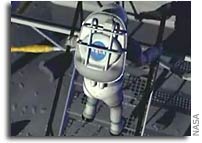Sensor System to Gauge Effects of Cosmic Rays on Lunar Explorers

NASA to provide BU $9.5 million for development and construction of CRaTER
instrument
Boston University Professor Harlan Spence recently joined five
other space scientists at Goddard Space Center in Greenbelt, Maryland to
discuss their participation in NASA’s Lunar Reconnaissance Orbiter (LRO)
program.
Spence learned in late December that his proposal for CRaTER, an
instrument that will measure and characterize the potential biological
effects of cosmic radiation on humans, was one of six selected by the
space agency for the LRO mission scheduled for fall 2008. A professor in
Boston University’s Center for Space Physics and a professor in and
chairman of the university’s Department of Astronomy, Spence is expected
to receive a contract for approximately $9.5 million for CRaTER. He and
the other principal investigators will each head institution-based
research teams that will build instruments to gather data on the lunar
environment, a vital first step in NASA’s preparation for what President
Bush has announced will be a series of human and robotic missions to the
moon.
CRaTER, which stands for Cosmic Ray Telescope for the Effects of
Radiation, will measure the high-energy charged particles (ions and
electrons, not “rays” at all) that travel throughout the cosmos at nearly
light speed. Consisting of a novel cosmic ray sensor system coupled with
proven analog and digital electronics, CRaTER will relay its data back to
Earth through the LRO spacecraft’s communication system.
The sensor system will be the scientific heart of the instrument.
Designed as a stack of detectors housed in a structure of aluminum and
special material known as tissue-equivalent plastic, the sensor system
will allow CRaTER scientists to measure and characterize the potential
biological effects of radiation that occur in deep space. The aim: gather
the data needed to develop equipment and materials that will ensure human
safety in the lunar environment.
“In 1971, I stood with my family in the throngs that watched Apollo 15
thunder into space from Cape Canaveral,” Spence recalls. “It was a
defining moment for me, hooking me on a career in astronomy and space
science. With CRaTER, I get to relive that excitement as a space
scientist — and get to experience my own voyage, of sorts, to the moon!”
Scientists on Spence’s team include Larry Kepko, senior research associate
in BU’s Center for Space Physics; J. Bernard Blake, director of the Space
Sciences Department at the California-based research group, The Aerospace
Corporation; Joseph Mazur, research scientist and laboratory manager at
Aerospace; Justin Kasper, a research scientist in MIT’s Center for Space
Research; and Lawrence Townsend, a professor of nuclear engineering at The
University of Tennessee in Knoxville. Team collaborators include Michael
Golightly of the Air Force Research Laboratory in Bedford, Massachusetts
and Terrence Onsager of the National Oceanic and Atmospheric
Administration’s Space Environment Center in Boulder, Colorado.
The LRO mission is part of NASA’s Robotic Lunar Exploration Program. In
2008, the orbiter will carry the instruments built by the teams into space
where they will begin gathering the information that will inform the
planning and execution of future lunar missions. The five other
NASA-selected teams are from Goddard Space Flight Center in Greenbelt,
Maryland; Northwestern University in Evanston, Illinois; Institute for
Space Research and Federal Space Agency in Moscow; University of
California in Los Angeles; and Southwest Research Institute in Boulder,
Colorado.
Faculty research in BU’s Department of Astronomy is coordinated through
its Institute for Astrophysical Research and its Center for Space Physics.
Research areas include observational and theoretical studies in galactic
and extragalactic astrophysics, magnetospheric and ionospheric physics,
planetary and cometary atmospheres, space weather, space plasma physics,
star formation and galactic structure, star and star clusters, active
galaxies and quasars, high-energy and particle astrophysics, galaxy
formation, and cosmology.
Boston University, with an enrollment of more than 29,000 in its 17
schools and colleges, is the fourth-largest independent university in the
United States.









